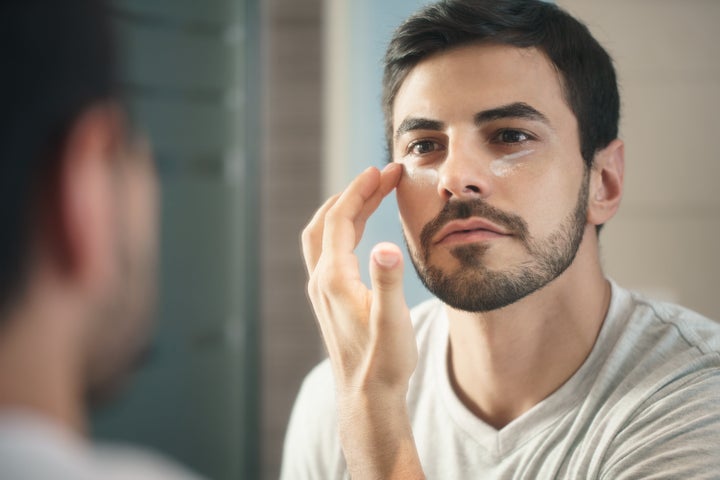
I have to admit, I’m rabidly obsessed with skincare. I begin with a gentle foaming cleanser, massaging it into my skin for a full sixty seconds like the gurus recommend. A hydrating toner next; sprayed. I’ll then dab in a peptide serum, wait to dry, followed by antioxidant-rich aloe vera-based hydrating serum to offset those free radicals. But only in the mornings.
Evenings, I alternate between a Retinoid 2% solution, Niacinamide 10% with Zinc 1% and Vitamin C treatments, to help soften the skin and aid in the production of collagen. You do them at night because they make your skin hypersensitive to sunlight. But SPF in the day is absolutely key. Must protect against those UVBs and UVAs. Once or twice a week I’ll also exfoliate – physically and chemically – typically with lactic acid but sometimes I’ll throw in some salicylic acid too, just for kicks.
You might think I’m crazy, which I am, but I’m certainly not alone.
Men’s interest in beauty has seen a spike in recent years. Research in the United States predicts the market will hit $166 billion by 2022, noting that men’s skincare sales have leaped 7% within the last year.
Who can we thank? YouTube beauty vloggers (hello, James Charles) alongside famed media personalities (Tan France, Jonathan Van Ness) have helped knock down some of the rigidity around gender performance, making it much more socially acceptable to dip a toe into the manicured market of beauty and wellness. Love Island, too, has purportedly left its mark, credited with driving a “16% sales surge in men’s skincare products in the 12 weeks to 12 August.”
It’d be naive to think that men’s appetite for appearance is an entirely recent phenomenon. In writing about the growth of men’s hair loss products for InStyle, Danielle Fredman maintains that: “Despite the millennial push for body positivity and inclusion, one realm of physical appearance still carries a stigma: balding.” The market has rebranded itself to fit the “wellness” zeitgeist, leaning into science for its marketable remedies and gravity-defying miracles.
But a quick flip through history books shows that men have always been innovative with the battle against their roots. While the toupée rapidly reached the heads of men throughout the 19th century, most notable appearances fall onto figures like Julius Caesar, known for donning the hairpiece to skunk off his pattern baldness. Et tu-pée, indeed.
“Should women, and increasingly men, have to pay more just to feel comfortable and confident in a society that disproportionately glorifies youth and beauty?”
So what is so distinct about our modern man’s dance with dermatology? It’s wildly fascinating examining the marketing ploys used to make men feel safe and comfortable in applying lotion to their face. The product packaging (typically black and bold) is perhaps an attempt to signal primitive bruteness, an appeal to the fragile masculinity that haunts our psyches. Earlier this year a men’s makeup brand went viral for all the wrong reasons when it launched its latest campaign, “War Paint”. The ad, featuring a well-muscular well-tattooed man, purportedly looked to dispel any lingering stigma, but fell heavily onto the hyper-militarised and masculine tropes that makes men engaging in anything feminine difficult in the first instance.
It’d be almost too easy to claim that the blossoming of men’s beauty is a sign of men finally “taking care of themselves”. No, instead corporations are getting better at imbuing the same anxieties into men that women have about their beauty and bodies – while selling the solutions back to us.
“Perhaps the ultimate form of “self care” would be leaving capitalism altogether.”
When we really start to interrogate it, beauty is all just one big conversation – a dialogue that we have about ourselves to ourselves and to each other. But the more we have the same conversation, the more we make solid the rigidity of what we deem attractive and most prized. Beauty is therefore entirely constructed through a hierarchy: an ideal standard that we unwillingly compare ourselves to. But it’s this standard that is so easily reproduced through mass media and manipulated and exploited by advertisers in a quest to tell us (and sell us) that we’re never really enough – fit enough, young enough, manicured enough.
Makeover shows, like the new revamp of Queer Eye, tend to rely on these anxieties and the forces of capitalism to assimilate participants into the normative standards of beauty and consumption. It’s undoubtedly true that many of their candidates walk away with a resurgent sense of confidence, but it’s a confidence that steps in line with the status quo. The fab five look to fix people, not the systems that make us feel inadequate in the first place.
Should women, and increasingly men, have to pay more just to feel comfortable and confident in a society that disproportionately glorifies youth and beauty? This explosion of men’s interest in beauty could be a sign of equality, sure – but it will quite literally come at a cost.
Perhaps the ultimate form of “self care” would be leaving capitalism altogether.
Yet who could blame us for wanting to just feel good. More often than not we’re left to play the only game that exists, and sometimes that game has five steps with an added exfoliation once or twice a week.
Dejan Jotanovic is a freelance writer.